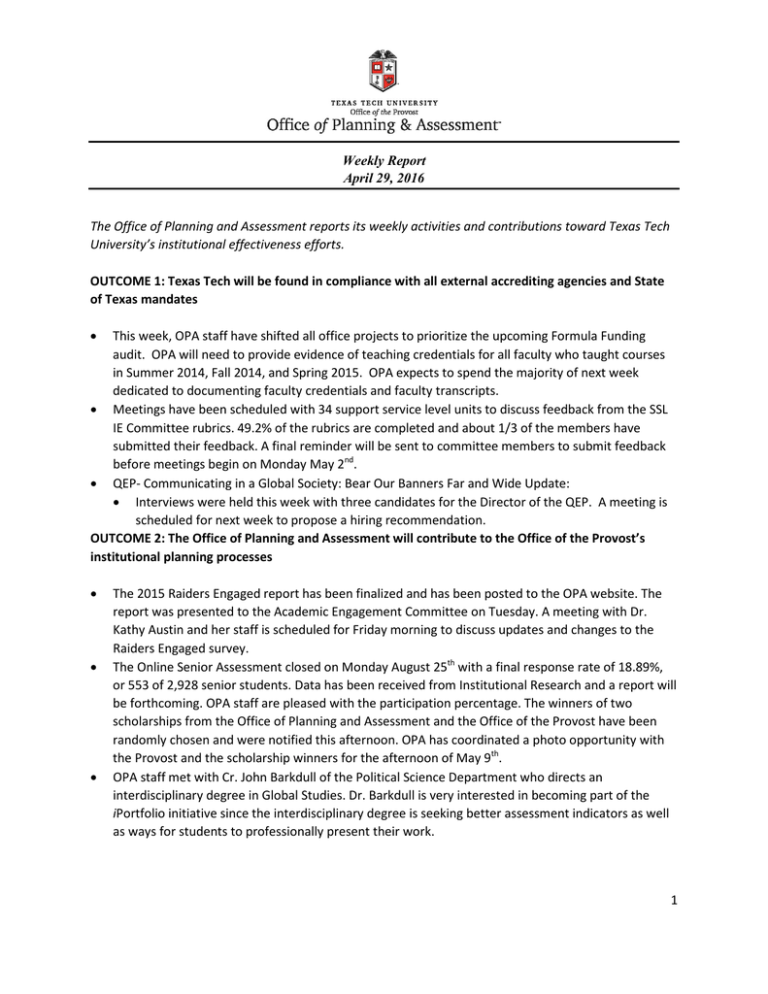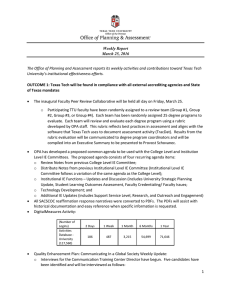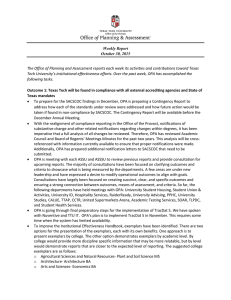Weekly Report April 29, 2016
advertisement

Weekly Report April 29, 2016 The Office of Planning and Assessment reports its weekly activities and contributions toward Texas Tech University’s institutional effectiveness efforts. OUTCOME 1: Texas Tech will be found in compliance with all external accrediting agencies and State of Texas mandates • This week, OPA staff have shifted all office projects to prioritize the upcoming Formula Funding audit. OPA will need to provide evidence of teaching credentials for all faculty who taught courses in Summer 2014, Fall 2014, and Spring 2015. OPA expects to spend the majority of next week dedicated to documenting faculty credentials and faculty transcripts. • Meetings have been scheduled with 34 support service level units to discuss feedback from the SSL IE Committee rubrics. 49.2% of the rubrics are completed and about 1/3 of the members have submitted their feedback. A final reminder will be sent to committee members to submit feedback before meetings begin on Monday May 2nd. • QEP- Communicating in a Global Society: Bear Our Banners Far and Wide Update: • Interviews were held this week with three candidates for the Director of the QEP. A meeting is scheduled for next week to propose a hiring recommendation. OUTCOME 2: The Office of Planning and Assessment will contribute to the Office of the Provost’s institutional planning processes • • • The 2015 Raiders Engaged report has been finalized and has been posted to the OPA website. The report was presented to the Academic Engagement Committee on Tuesday. A meeting with Dr. Kathy Austin and her staff is scheduled for Friday morning to discuss updates and changes to the Raiders Engaged survey. The Online Senior Assessment closed on Monday August 25th with a final response rate of 18.89%, or 553 of 2,928 senior students. Data has been received from Institutional Research and a report will be forthcoming. OPA staff are pleased with the participation percentage. The winners of two scholarships from the Office of Planning and Assessment and the Office of the Provost have been randomly chosen and were notified this afternoon. OPA has coordinated a photo opportunity with the Provost and the scholarship winners for the afternoon of May 9th. OPA staff met with Cr. John Barkdull of the Political Science Department who directs an interdisciplinary degree in Global Studies. Dr. Barkdull is very interested in becoming part of the iPortfolio initiative since the interdisciplinary degree is seeking better assessment indicators as well as ways for students to professionally present their work. 1 OUTCOME 3: The Office of Planning and Assessment will continually monitor the university’s compliance with laws, policy statements, and policies deriving from the State of Texas, THECB, and SACSCOC • THECB: A Power Point presentation was published from the 38th annual Texas Association for Institutional Research (TAIR) Conference held on March 1, 2016. This was presented by Dr. Kathleen Fenton & Dr. Larry J. King and was titled “Assessing the Texas Core Curriculum: Characterization and Comparison Across Texas Public Colleges and Universities.” Several interesting and pertinent facts were outlined as follows: o 15 core courses shared by 75% or more of all Texas public institutions include ENGL 1301 Comp I, ENGL 1302 Comp II, HIST 1301 US History I, HIST 1302 US History II, GOVT 2305 Fed Government, GOVT 2306 Texas Government, PSYC 2301 General Psychology, SOCI 1301 Intro Sociology, ECON 2301 Princ of Macroecon, MUSI 1306 Music Appreciation, MATH 1314 College Algebra, ARTS 1301 Art Appreciation, DRAM 1310 Intro to Theater, ECON 2302 Princ of Microecon, MATH 1324 Math for Bus/Soc Sci, MATH 2413 Calculus I o 33 of 73 institutions use some direct external measure as assessment plans including ETSPP, CLA, CAAP, CAT, GPI, national disciplinary exams, and other exams o 45 of 73 institutions report using some indirect external assessment measurements including CCSSE, NSSE, SENE, locally developed surveys, student course evaluations, and other surveys o 100% of 73 institutions report using some direct internal assessment including embedded exam rated by instructor, embedded exam using rubric, discipline coordination of instructor ratings, blind-review by discipline, embedded assignments that are blind reviewed by institution wide committees using a rubric, and others o 10 of the 73 instructions reporting plan to use portfolios as follows: assessing portfolios, instructor rated portfolios, blind reviews of portfolios by department or disciplinary committees, blind reviews by institution wide committees o 49 of 73 institutions use some type of rubrics for assessment; most rubrics have a 4 point scale o 12 of 73 institutions named software they use for Core assessment: WEAVE, Blackboard, Pearson’s Learning Studio, TracDat, SPOL, STC PRIDE, and internally developed systems OUTCOME 4: Texas Tech University faculty and staff will be well-prepared to meet OPA’s faculty credentialing, assessment, and strategic plan expectations • • Earlier this year, the Office of Planning and Assessment was asked to assist the department of Human Development and Family Studies in their strategic planning review. A follow-up meeting was held to further discuss how OPA can contribute to developing measurable action statements. OPA is working with DigitalMeasures to design a custom area and screens for Annual Report processing and signing. 2 In addition to direct contributions toward the departmental goals, OPA continues to focus on continuous improvement measures. • • Two proposals from the Office of Planning and Assessment for the SACSCOC Annual Meeting were accepted. o A Practical Guide for Completing the Student Learning Outcome Assessment Cycle- As institutions of higher education strive to meet the increasing expectations of accrediting and regulating agencies, they are becoming more aware of the need for stronger processes. This ever-growing attention to excellence is most notable with student learning assessment. Through effective processes, not only is an institutional effectiveness model created, but also there is stronger internal integrity, institutional communication, and dedication to excellence. Presenters will present a process that has been developed in direct response to the need to provide meaningful and effective feedback to departments as well as one that provides datadriven information to central administration. Communicating with Faculty Members to Achieve Assessment Compliance - Because higher education faculty directly impact student learning, it is important to understand how they perceive their roles in academic assessment and how they communicate their involvement in, and commitment to, academic assessment practices (Lee, Zhang, & Yin, 2011). Faculty may have different points of contact with academic assessment. Assessment professionals need to understand how faculty incorporate academic assessment practices into their professional routines and rituals, so that institutional leaders can provide better resources and smarter strategies to gain the compliance of faculty on academic assessment tasks (Daniels, 2011). To effectively measure student learning, assessment professionals need to understand how to provide resources for faculty that will ultimately lead to gains in student learning performance (Banta, 2007). OPA consulted, along with Daniel East, about TTU’s DigitalMeasures experience with East Carolina University. They are looking into purchasing DigitalMeasures. 3











